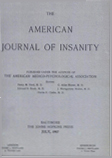THE TREATMENT OF CHILDHOOD SCHIZOPHRENIA BY METRAZOL SHOCK MODIFIED BY B-ERYTHROIDIN
Abstract
The method of modification of the metrazol seizure by beta-erythroidin hydrochloride used by other investigators is here applied to the treatment of schizophrenic children, in whom the incidence of fractures sustained by unmodified metrazol convulsions appears high.
The physiological effect of the drug is discussed in its application to the diminution of strength of muscular contraction, and modification of the convulsion.
Modification of the seizures has resulted in preventing fractures in 9 of 1O cases, the tenth patient sustaining a fracture through a delayed, unmodified seizure. It is suggested that by avoidance of the use of prostigmine, the danger of this complication may be decreased. The safety of this method of modification is assured by careful technique of administration.
Clinical results show that 8 of 9 schizophrenic children treated (including two previously treated by unmodified shock) have shown improvement in response to metrazol therapy. Final evaluation of the efficacy of metrazol treatment in these cases must necessarily await further observations, to determine whether patients treated by this method show a better remission rate than the low figures for spontaneous remission indicate.
Access content
To read the fulltext, please use one of the options below to sign in or purchase access.- Personal login
- Institutional Login
- Sign in via OpenAthens
- Register for access
-
Please login/register if you wish to pair your device and check access availability.
Not a subscriber?
PsychiatryOnline subscription options offer access to the DSM-5 library, books, journals, CME, and patient resources. This all-in-one virtual library provides psychiatrists and mental health professionals with key resources for diagnosis, treatment, research, and professional development.
Need more help? PsychiatryOnline Customer Service may be reached by emailing [email protected] or by calling 800-368-5777 (in the U.S.) or 703-907-7322 (outside the U.S.).



